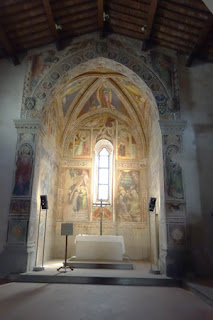Sometimes people tell me, “Wow, you are so
courageous to just pick up and move to Italy.” Well, first of all, that is not
exactly what happened, and it took me years to finally find a place to call
home and … whatever. I usually respond
with a confused look and a, “What? Italy
is not Afghanistan. And anyone with a
credit card can come to Italy. I am not
particularly special.”
Still, to live outside of the country you
were born in is not at all the same as visiting a foreign country. And thankfully, at least in my experiences,
there are many people, Italian and other expats alike, who really help
out. [I use the term ‘expat,’ which to
some is a bit controversial, to mean someone, like me, who chooses to live
outside her native country, but has not given up her citizenship in her native
land; versus an immigrant who either has given it up or has become a dual
citizen.]
It was in this context of neighbors
helping neighbors with health insurance issues that I found myself going again
near the hospital in Pescia, Italy, the nearest decent-sized town to where I
live. We were looking for a specific
office/person to help with my neighbors’ health-insurance, a tip from an
Italian neighbor. But this time, on the
walk down a somewhat familiar street, a rather plain old wooden door invited a look inside. I was surprised to see
frescos and a dramatic light emerging inside washing over the art. So, this was a small old church tucked into modern
surroundings.
Ever curious, but aware that we were in a
hurry to find this person, I quickly snapped some images and gazed up a bit to try
to understand what treasure we had discovered in this little city once famous
for its flower productions.
It is the Oratory of Saint Antonio Abate. There
was a date in the sign of 1210-1220, but I had too much glare on the laminated
sign and am unclear on what the date refers to.
However, the organ at the back was constructed on 1853 by Nicomede
Agati. And the wooden sculpture [Umbrian-Tuscan sculptor of the late nineteenth century. XIII
Deposition of Christ, carved and painted wood], was affected by the great flood
in Florence of 1966. Well here is the
translation of part of the sign I photographed in the oratory:
“The part of the
Superintendence at the Galleries was mainly in the recovery of the famous
Romanesque wood group. It had been restored for the first time in 1943, albeit
with poor results because the technical means available at that time had failed
to block the process of infestation and disintegration of the wood, which was
for the second time hospitalized in the workshops of the Superintendence at the
Galleries Of Florence, had the misfortune to suffer on 4 Nov 1966 the flood
water damage.”
As for the fresco
around the altar, it seems to have been restored in 1975. Enjoy the snapshots!
Peace,
Kelly Borsheim, artist
 |
| wood ceiling typical of long ago |
 |
| wood sculpture, restored again after great flood 1966, Firenze |
 |
| the ceiling fresco |
 |
| the organ at the back was constructed on 1853 by Nicomede Agati |






1 comment:
Great find! Beautiful photos. Thanks, Kelly.
All fine here, a bit hot! Off to NM again in August.
Post a Comment